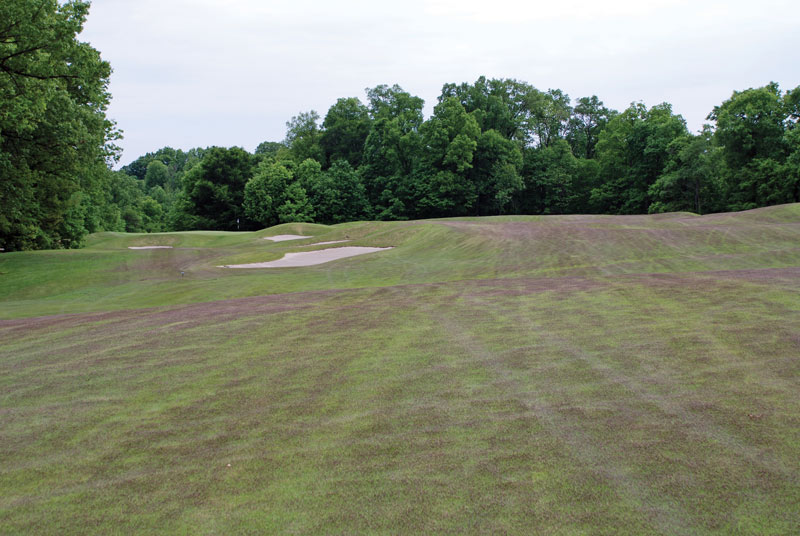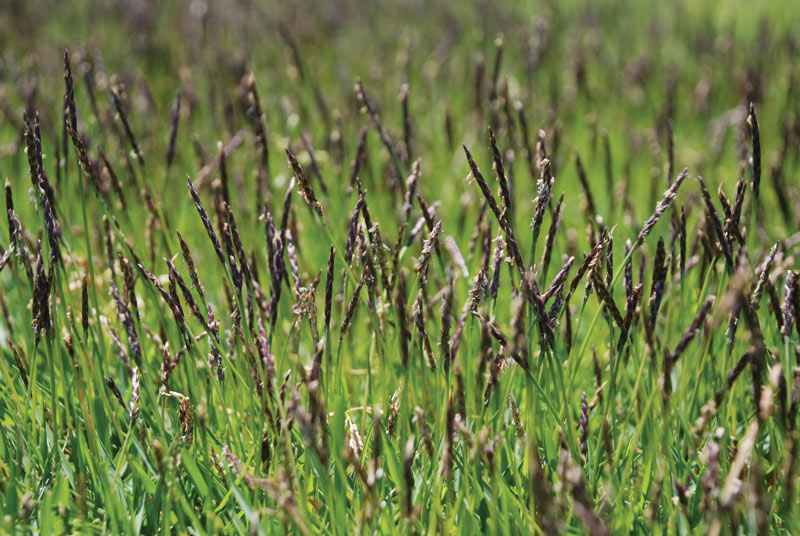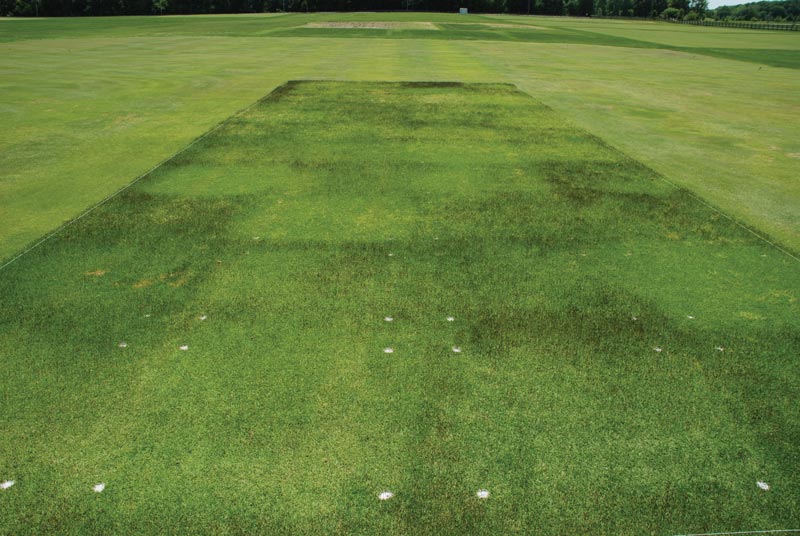
Seedhead development on a Meyer zoysiagrass fairway in spring can cause dark purple coloration. Photos by Aaron Patton
Editor’s note: This research is funded in part by the Environmental Institute for Golf.
Zoysiagrass is widely used on golf course tees and fairways in the transition zone and is recognized for its low requirements for water, fertilizer and pesticides inputs (1). However, zoysiagrass commonly produces seedheads in late spring, which discolors the turf and results in poor mowing quality. To help maintain acceptable turfgrass quality during seedhead development, additional mowing is required, more maintenance is needed on mowers, and more expenditures are needed for labor. Research is needed to better understand the progression of seedhead development in zoysiagrass, and to determine the most effective timing of ethephon (Proxy, Bayer) for seedhead suppression.
Objectives
Our objectives in 2019 were: 1) to sample zoysiagrass to inspect for seedhead development in autumn; 2) to further narrow effective application dates of ethephon for seedhead suppression in Meyer zoysiagrass, and to initiate an experiment on Innovation zoysiagrass; and 3) to begin development of a model that can be used to guide ethephon application based on weather data.
Progress toward objectives
Sample zoysiagrass periodically in autumn and spring to determine seedhead initiation and correlate development with environmental conditions
Meyer zoysiagrass plugs were sampled from untreated turf weekly from Sept. 11 through Oct. 23, 2019, at the Rocky Ford Turfgrass Research Center in Manhattan, Kan. At least five shoots were dissected from each plug and observed under a dissecting scope to observe changes in morphology related to seedhead initiation. No particular morphological structures related to seedhead development were observed. Sampling will begin again in early spring 2020.

Unmowed seedheads of Meyer zoysiagrass have a distinctive dark purple color.

Seedhead suppression in May on plots in Indiana treated with Proxy (active ingredient ethephon) at 5 fluid ounces/1,000 square feet during the previous autumn.
Determine the optimal window for effective Proxy applications for Meyer zoysiagrass and Innovation zoysiagrass seedhead suppression
Field research was conducted in Kansas and Indiana on Meyer zoysiagrass to evaluate the efficacy of Proxy for seedhead control. Proxy was applied at 5 fluid ounces/1,000 square feet (15.9 liters/hectare) to separate plots weekly between August and October. Seedheads were controlled 0% to 99% depending on application timing. Application timings in Indiana and Kansas generally performed similarly. In Indiana, applications between Aug. 30 and Oct. 2 provided >82% seedhead control. In Kansas, applications between Aug. 30 and Sept. 18 yielded >65% seedhead control. Applications beyond Oct. 9 resulted in <21% seedhead control in both Indiana and Kansas. Application timing for seedhead suppression in this experiment is consistent with a previous report (2). This research defines the optimal fall application window for spring zoysiagrass seedhead suppression across a broad geographic range.
For evaluation of seedhead suppression on Innovation zoysiagrass, an experiment was initiated at the Rocky Ford Turfgrass Research Center in Manhattan, Kan. We applied Proxy weekly on different plots, just as we had for Meyer, beginning on Aug. 28 and ending on Nov. 6. Each weekly application was replicated three times. Seedhead production will be evaluated in spring 2020.
Model optimal Proxy application timing using environmental data
An additional series of ethephon applications was made to Meyer zoysiagrass in late summer and autumn 2019 using identical methods to those described for the Innovation zoysiagrass study above. These data will be combined with data collected earlier in Kansas, Indiana, Tennessee and Arkansas. Weather data were collected at on-site weather stations at each location throughout the 2018 and 2019 experiments to allow for development of a model that can be used to guide optimal application time. Data to be collected for use in modeling include date, day length, cooling degree days (air temperature) and soil temperature at a depth of 2 inches (5 centimeters). Regression analysis will be used to help model seedhead development using environmental data.
Literature cited
- Fry, J., M. Kennelly and R. St. John. 2008. Zoysiagrass: Economic and environmental sense in the transition zone. Golf Course Management 76(5):127-132.
- Patton, A.J., G.P. Schortgen, J.A. Hoyle, M.S. Harrell and Z.J. Reicher. 2018. Fall applications of Proxy (ethephon) suppress spring seedheads of ‘Meyer’ zoysiagrass. Crop, Forage & Turfgrass Management 4:180012. doi:10.2134/cftm2018.03.0012
Jared Hoyle is an assistant professor, Jack Fry is a professor in the Department of Horticulture and Natural Resources, and Megan Kennelly is a professor in the Department of Plant Pathology at Kansas State University, Manhattan, Kan. Aaron Patton is interim department head and a professor of horticulture in the Department of Horticulture and Landscape Architecture at Purdue University, West Lafayette, Ind.